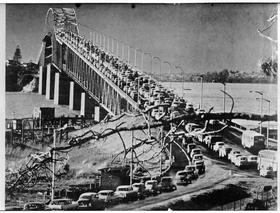
The end of Hamer Street provides a view of one of Auckland’s best known landmarks, the Auckland Harbour Bridge. In 1950, after several failed earlier attempts to bridge the Waitemata Harbour, the Auckland Harbour Bridge Authority was formed with the purpose of constructing and managing a harbour crossing for vehicles. The steel lattice girder structure that you see here was designed by UK engineers, Freeman Fox & Partners. It was fabricated in UK and built by Cleveland Bridge and Dorman Long (Auckland) between 1955 and 1959. The bridge cost £7.5 million, partly recuperated by a bridge toll that was in place until 1984. This early bridge was four lanes wide.
The bridge remains the largest in New Zealand, with seven cantilever and suspended span sections set on six concrete and steel piers held together by seven high-tensile steel pin joints. The total length is 1,097m with a main span of 243m set 42m above mean sea level. A gap, or expansion joint, above pier three allows for temperature variation movements of up to 45.75cm.
A problem was experienced when sinking pier five. When the caisson was lowered, the cutting edge hit a layer of harbour bed of uneven strength and it heeled over. Anxious workers excavated for ten days before the caisson sank on to a layer of hard sandstone and righted itself.
The initial spans of the bridge were erected on false work and the proceeding spans cantilevered out. Because of the expansion joint it was impossible to use the same method for the large span (146m) between piers three and four. In ‘Operation Pickaback’, the solution was to fl oat the span into place on the back of another mounted on four pontoons at high tide. At the time this was regarded as a highly innovative feat and was widely admired.
Within a decade traffic exceeded the bridge’s capacity. Between 1966 and 1969 the bridge was ingeniously expanded from four to eight lanes. Prefabricated hollow steel box girder extensions, designed by Freeman Fox & Partners and manufactured in Japan, were positioned by huge floating cranes and ‘clipped’ on to the existing piers using steel brackets cantilevered out and fixed by massive ‘thru bolts’. The additional four lanes were somewhat affectionately known as the ‘Nippon Clip-ons’. The bridge extensions cost £13.25 million, nearly twice that of the original bridge construction 10 years previously.
Following the discovery of some buckling, the box girders were strengthened in the early 1970s and in the 1980s, 2,000 splice joints were replaced using new techniques, after the discovery of some fatigue cracks by the Ministry of Works.
In 1990 a moveable concrete median barrier designed in Australia was installed to manage traffi c flows. It is moved four times a day by purpose built vehicles and was a world first.
The Auckland Harbour Bridge has received an IPENZ heritage plaque.